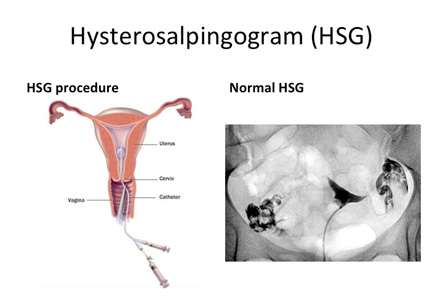Hysterosalpingogram
Introduction
A hysterosalpingogram or HSG is an important diagnostic test for evaluating female fertility potential. The HSG test is a radiological procedure usually done in the radiology department of a hospital or outpatient setup having radiology facility.
In this procedure, a radio-opaque contrast or dye is injected into the uterine cavity through the vagina and cervix. The uterine cavity fills with dye and if the fallopian tubes are open, dye fills the tubes and spills into the abdominal cavity.
This can evaluate the tubal factor of infertility. It confirms whether the fallopian tubes are open or blocked and also finds the site of blockage in the tube. The blockage can be at the junction of the tube and uterus (called as proximal) or at the abdominal end of the tube (distal).
If the tubal factor of infertility is found to be present, it can be treated early and couples can conceive in result.
The hysterosalpingogram study only takes about 5 minutes to perform

Other things that can be seen on a hysterosalpingogram include:
1. Presence of congenital uterine anomalies, polyps, fibroid tumors or uterine scar tissues can be diagnosed by evaluating the uterine cavity.
2. Partial blockage of fallopian tubes, defects in the tube or pelvic scar tissue in the abdominal cavity near the tube can be diagnosed by this examination.
Procedure:
1. The hysterosalpingogram study only takes about 5 minutes to perform. The test is usually done in the radiology department or operation room having X-ray facility of a hospital so there is additional time for the woman to register at the facility and fill out a questionnaire and answer questions regarding allergies to medication etc. The way the test is done is the following:
2. The position for the procedure is lying on the back on an examination table with feet raised and supported by foot rests or foot stirrups.
3. An instrument with smooth, curved blades known as speculum is inserted in the vagina to visualize the opening of uterus known as cervix.
4. For injecting the dye, a soft, thin catheter may be passed through the cervical opening into the uterine cavity. Otherwise, an instrument called as a tenaculum is placed on the cervix and then a narrow metal cannula is passed into the cervical opening.
5. This catheter or cannula is used for injecting the contrast dye into the uterine cavity.
6. An x-ray shoot is taken as the uterine cavity fills with the dye and then additional contrast is injected to fill the tubes and to spill into the abdominal cavity. More x-ray pictures are taken of this filling and spilling.
7. After confirmation of tubes spilling the dye (this means tubes are patent), the woman is asked to roll to one side or the other slightly. In this position, a slightly oblique x-ray shoot is taken to further delineate the anatomy of the organs.
8. At this stage, the procedure is considered complete and all the instruments are removed from the cervix and vagina.
9. The woman is made to lie on the table for a few minutes till the cramping caused by injection of the contrast subsides.
10. The results of the X-ray films are usually immediately available and they can be reviewed with couple several minutes after the procedure is complete.
Chance for getting pregnant after HSG:
Pregnancy rates are postulated to increase very slightly in the first month following the test of hysterosalpingography. This can result from flushing of the tubes which can open minor blockages or clean out some debris that may be the cause of preventing the couple from conceiving.
Using oil based contrast provides a slightly larger increase in pregnancy rates than the use of water based contrast.
Complications associated with a hysterosalpingogram include:
1. An allergic reaction to the contrast which is uncommon. This causes usually a rash, but rarely can be more serious.
2. Pelvic infection
3. Perforation of uterus is possible, but this is very rare.
If a woman has multiple sexual partners or has other risks for sexually transmitted diseases, she is usually screened with cervical cultures before performing an HSG. A course of antibiotics may be prescribed by some physicians before the procedure to reduce risk of infection after HSG.